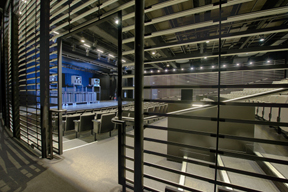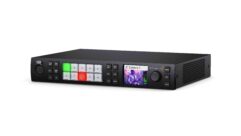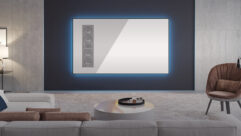
SVC Podcast – Show Notes – Show 153-2
In this edition of the SVC Podcast, SVC Contributing Editor Bennett Liles talks with Pierre Germain, Constellation design manager with Meyer Sound. They discuss the newly rebuilt and re-opened San Francisco Museum of Modern Art and its Phyllis Wattis Theater. The theater is equipped with active acoustics in the form of a Constellation acoustic system, which uses microphones and speakers rather than walls and panels to change the theater’s acoustic signature. Pierre provides the details of his design and a demonstration of Constellation.
For Part 1
Links of interest:
- Meyer Sound Laboratories, a world leader in acoustics and sound reinforcement
- The San Francisco Museum of Modern Art expansion and renovation
- Constellation Active Acoustic System
- Video – John Pellowe of Meyer Sound explaining the Constellation system
- Video – The Constellation system in Logomo Hall: Turku, Finland
Download Podcast Here:
https://s3.amazonaws.com/nb-svc/public/public/153-2_SFMOMA_Pierre_Germai…
From Sound & Video Contractor Magazine, this is the SVC Podcast with Pierre Germain of Meyer Sound. Show notes for the podcast are on the web site of Sound & Video Contractor Magazine at svconline.com.
The long anticipated re-opening of the San Francisco Museum of Modern Art is here and the Phyllis Wattis Theater has unveiled its new Constellation active acoustic system from Meyer Sound. Pierre Germain is here from Meyer Sound to tell us how he designed and set up the new Constellation system that changes the whole facility’s sound with the push of a button. That’s all up next on the SVC Podcast.
Pierre thanks for being with us here on the SVC Podcast from Meyer Sound in San Francisco. This is a big project. We were talking with Duncan Ballash in Part 1 about the re-opening of the San Francisco Museum of Modern Art now equipped with active acoustic technology in the form of the Meyer Sound Constellation system. So take us through the concept at work here. How does active acoustic technology work?
It’s called active acoustic technology, but it’s also a passive way of changing room acoustics. Active acoustics is a method of changing the reverberation time and the acoustics of a space just to suit it to different needs. So you can have a cinema space that can be changed into a cathedral or chamber music hall or concert hall all electronically. So traditionally the way that’s been done has been using passive materials like curtains or soft panels that can be moved in and out to change the reflective nature of certain walls and ceilings. Another way of doing that passively is to use coupled chambers which are additional hallways that can be exposed to the room to increase the volume which also increases the reverberation time. So the way active technology works, it’s a system of microphones and speakers and digital signal processors that work with the room and can change its properties electronically. So you’re essentially replacing walls and ceilings with microphones and speakers, virtually, and that way you can manipulate the shape of the room and the sound of the room.[Timestamp: 2:15]
And that would give you just a whole new dimension of control over everything.
Absolutely. We can control the apparent depth, the apparent height. We can make one wall seem like it’s 100 feet away or 10 feet away. We can really manipulate a lot of the different parameters that you can’t really do in a physical space. For instance, you can adjust the bass ratio – how much base that you want in the room – or the brightness. So the frequency ratio, the sound level – how loud you want it – and also just the overall apparent shape of the room can all be adjusted. [Timestamp: 2:45]
A huge advantage because of the widely-varied nature of the things that are planned to happen in the Phyllis Wattis Theater. It’s such a wide range of different events they want to be able to do that physical room acoustics might be a compromise at best. For instance, how would you set up a Constellation system differently for a symphonic concert than, say, maybe a lecture or panel discussion?
The only difference is for a panel lecture instead of using a long reverberation time we actually use a very short reverberation time. And using the early reflections processor we just use those signals to be broadcast throughout the entire space. We call that a classroom setting. It keeps it very intimate, but at the same time it actually maintains the clarity by not introducing very much reverberation, but rather the early reflections that are essential for speech intelligibility and clarity. Whereas for a symphonic setting, we still have the early reflections to maintain the clarity, but then we have the reverberation which follows it, and that way you get the envelopment and you get the impression that you’re in the concert hall. [Timestamp: 3:49]
Of course, the physical basis of this is lots of microphones and speakers all working together, so what type of microphones would you put in there? Obviously, they’re specialized for that type of use, I guess.
Yes, correct. We have two different microphones in the Wattis. We have our miniature cardioid microphones in the over-the-audience area, and the stage has our compact cardioid microphones, so they’re both cardioid patterns. The ones on stage are a little bit tighter cardioid pattern for a little bit more control. [Timestamp: 4:16]
And the speakers I would think might be fairly directional?
Most of them are 100-degree conical speakers. So the ones up in the ceiling – both on stage and in the audience – are 100-degree conical. The cinema surrounds, which also double as Constellation lateral speakers, are also 100-degree conical. There are smaller speakers, the MM4’s that are embedded in this transondent wall, those are 80-degree conical. And onstage the lateral speakers are horn-loaded and those are 50-degree vertical and 80-degree horizontal. [Timestamp: 4:47]
And I guess it’s interesting sort of on another dimension of this, trying to design the sound for the range of events in the Wattis Theater, and a lot of these may involve audience participation where there can be conversation going back and forth between the audience and the stage.
Correct. Yes. They can use the classroom setting for that so they can have participation from the audience, and again it’s a very short reverberation with early reflections where we can maintain the clarity. So wherever you’re sitting there’s a microphone that’s nearby and you can talk to somebody on stage. It’s one of those theaters that it was small enough that you’re able to do something like that. Everything came together really well in terms of the design from the architect and acoustician. That made all of that happen. [Timestamp: 5:30]
Yeah, I was kind of wondering about the time frame on this because there’s nothing more hard and fast on the finish date than the re-opening of this very high profile facility.
Correct.
What sort of time frame were you working under? Not much high pressure or were there some things that were maybe unexpected?
It worked out really well. I remember this project started just before Christmas, I think two years ago, where we did the initial design. The rest of the process was kind of a typical process to go through with architects and acousticians. We started with our ideal design. We lay out the speakers and microphones where we ideally would like to have them. Then we have to negotiate with obstructions such as HVAC’s and lights and beams and that sort of thing. So it was very smooth communication between all of the three parties and it worked out really well. [Timestamp: 6:16]
I would think that just using active acoustic technology and knowing this from the beginning and designing the facility for it, you could potentially come up more than nice aesthetics but actually save tons of time and money.
Yes. Absolutely. That’s the beauty of active architecture is you’re able to transform a small room into much bigger rooms that would normally require a bigger footprint and therefore more impact on the cost of the building and the cost of running the building. So a room of this size, which I believe is only about 200 seats, making it sound like a concert hall is just such a huge advantage. So it gives them flexibility, especially in a museum space, to do all sorts of different events all in a small, compact theater. [Timestamp: 6:57]
This was a super high profile project and there has been a lot of publicity about it. What was the most difficult or challenging part of installing the Constellation system in this particular venue?
I’d say the most challenging part was there’s these transondent walls that frame the seating area. So when you enter the theater, you have the physical walls and then as you walk up – so essentially that creates a vomitory between the transondent wall and the physical wall. But we do have our cinema speakers around the physical wall and they have to shoot through the transondent wall. So there was a lot of design meetings to look at the metal slats that we were doing in this wall to make sure that it wasn’t compromising the frequency pattern of the speakers. So it was a great collaboration between EHDD, BBI the installer, and Arup, the acoustician. They did some testing at their office. BBI did some good ray tracing analysis to give some guidance to the architect in terms of the angle and the depth and the size of these slats in the metal wall. And that worked out really well. Once we tested everything onsite, everything worked out perfectly and our speakers sounded great. So I would say that would be the challenge. In addition to that, we also added some speakers inside the slats. It worked out that the spacing fit our speakers perfectly. So it was one of those challenges that in the end worked out perfectly. [Timestamp: 8:19]
A lot of details on the setup of this but you’re not really going to have to go through all of those every time you change presets for different events so how do you control the system in the Wattis Theater?
It’s controlled by a Crestron panel which controls other systems in the room, which is pretty typical for a Constellation system. The main presets are all in the Creston panel and if they want to have the ability to go into each preset and manipulate things a little bit, they have a web page that we program that they can access from a computer or an iPad where they have the main presets. And then they have a details page where they can go and adjust things here and there. So if they have a symphony setting and they want to make it a little bit quieter, they have the ability to do that. [Timestamp: 9:00]
Well, that would really be something to see when you’re operating this. When you install the mics and speakers are they pretty much installed the same way from one venue to another or do the natural acoustics of the room determine the placement and separation of the various physical elements?
Yeah, exactly. The base room acoustics kind of sets the distance between microphones and speakers that we want to set and space them at. And then apart from that, depending on the size of the room, it can rally change the type of speaker that we’re using, because we want to make sure we have enough sound power in the system. And then we try to have as much even spacing as possible to try to cover as many areas, and then we also have, in areas where speakers might end up closer to listeners, we have a higher density of speakers to make sure that you’re not localizing to one particular speaker. [Timestamp: 9:44]
So when you got all of this in and got it set up, the really fun part of it has to be the demo when you get to show the system off and show what it can do. People actually go beyond the verbal descriptions and hear what it can do for the first time. So what kind of reactions did you get when you first demoed this for everybody?
That’s always a lot of fun. We usually leave that for the last day of the tuning. What we typically do is – and we did this here – we invited musicians to come and play for us. In this case we had a quartet from the San Francisco Symphony. They came in and played and mostly – at first they started with our chamber setting. We got them to play some up tempo pieces and some staccato pieces and some pizzicato. And just turning the system on and off, the reaction is usually gasps from the audience, which is – that’s the best reaction. And musicians just have this sensation of – they always tell me when the system is turned off they feel very exposed. They feel like they’re not integrated with the room at all. It’s always great to hear the reactions of both the audience and the musicians. And then we went on to playing – they played slower legato pieces and we changed it to symphonic setting and even the cathedral setting. The difference between the cathedral setting and the system off is really dramatic because it’s about a five second reverberation time in the cathedral setting and then we turn it off and it goes back to the natural room acoustics, which is half a second. So it’s really dramatic. A lot of people had their phones out videotaping the on/off because it really is quite staggering. [Timestamp: 11:13]
Yeah, I can imagine for musicians in particular. They can go from playing in a symphonic hall to playing in a closet with the push of a button.
Absolutely, yeah.
Well this type of theater would be the first thing that comes to mind but I would imagine that this active acoustic system can do a lot of other things in a variety of other venues.
Constellation is obviously an ideal solution for a range of applications. It applies not only in the arts community, but also corporate and education and restaurants. So the system has been expanded to meet the needs of many different markets now. [Timestamp: 11:44]
That’s a whole new technology that can be applied probably in a lot of places we haven’t even thought of yet.
Exactly, yeah. New ideas come up every day, so don’t be surprised to see Constellation in a place you wouldn’t expect it.
Well, this has been great, between these two podcasts to explore the new re-opening of the San Francisco Museum of Modern Art and its new Constellation system from Meyer Sound and Pierre Germain, the acoustics engineer behind it all on the Meyer system. Thanks for giving us the details on how this all works. It’s really been fun to listen to.
Thanks for having me.
Thank you for being here with us for the SVC Podcast with Pierre Germain of Mayer Sound. Show notes are on the website of Sound & Video Contractor Magazine at svconline.com. Be right back here with us next week for SVC Podcast.










